英语可数名词与不可数名词[1]
- 格式:doc
- 大小:24.50 KB
- 文档页数:3

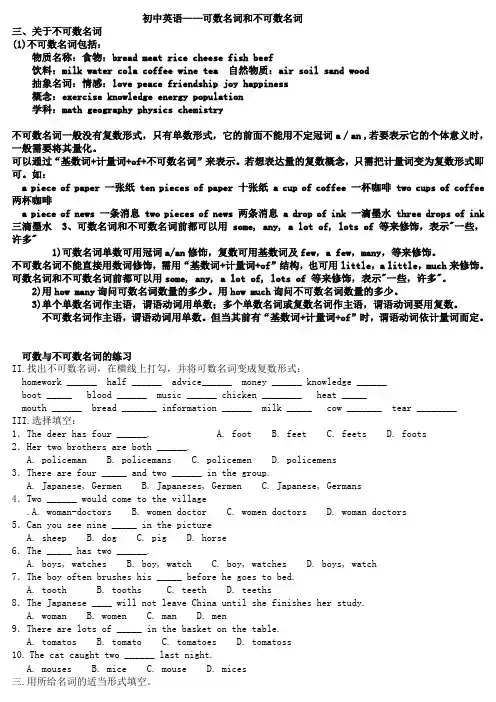
初中英语——可数名词和不可数名词三、关于不可数名词(1)不可数名词包括:物质名称:食物:bread meat rice cheese fish beef饮料:milk water cola coffee wine tea 自然物质:air soil sand wood抽象名词:情感:love peace friendship joy happiness概念:exercise knowledge energy population学科:math geography physics chemistry不可数名词一般没有复数形式,只有单数形式,它的前面不能用不定冠词a / an ,若要表示它的个体意义时,一般需要将其量化。
可以通过“基数词+计量词+of+不可数名词”来表示。
若想表达量的复数概念,只需把计量词变为复数形式即可。
如:a piece of paper 一张纸 ten pieces of paper 十张纸 a cup of coffee 一杯咖啡 two cups of coffee 两杯咖啡a piece of news 一条消息 two pieces of news 两条消息 a drop of ink 一滴墨水 three drops of ink 三滴墨水3、可数名词和不可数名词前都可以用some, any, a lot of, lots of 等来修饰,表示"一些,许多"1)可数名词单数可用冠词a/an修饰,复数可用基数词及few,a few,many,等来修饰。
不可数名词不能直接用数词修饰,需用“基数词+计量词+of”结构,也可用little,a little,much来修饰。
可数名词和不可数名词前都可以用some, any, a lot of, lots of 等来修饰,表示"一些,许多"。
2)用how many询问可数名词数量的多少。
用how much询问不可数名词数量的多少。
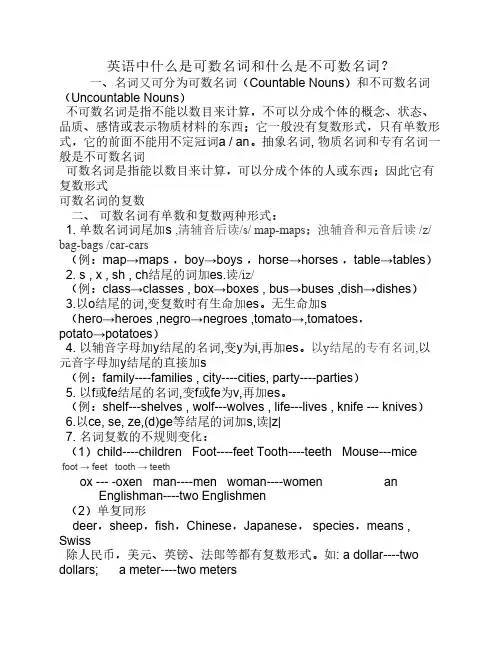
英语中什么是可数名词和什么是不可数名词?一、名词又可分为可数名词(Countable Nouns)和不可数名词(Uncountable Nouns)不可数名词是指不能以数目来计算,不可以分成个体的概念、状态、品质、感情或表示物质材料的东西;它一般没有复数形式,只有单数形式,它的前面不能用不定冠词a / an。
抽象名词, 物质名词和专有名词一般是不可数名词可数名词是指能以数目来计算,可以分成个体的人或东西;因此它有复数形式可数名词的复数二、可数名词有单数和复数两种形式:1. 单数名词词尾加s ,清辅音后读/s/ map-maps;浊辅音和元音后读 /z/ bag-bags /car-cars(例:map→maps ,boy→boys ,horse→horses ,table→tables) 2. s , x , sh , ch结尾的词加es.读/iz/(例:class→classes , box→boxes , bus→buses ,dish→dishes)3.以o结尾的词,变复数时有生命加es。
无生命加s(hero→heroes ,negro→negroes ,tomato→,tomatoes,potato→potatoes)4. 以辅音字母加y结尾的名词,变y为i,再加es。
以y结尾的专有名词,以元音字母加y结尾的直接加s(例:family----families , city----cities, party----parties)5. 以f或fe结尾的名词,变f或fe为v,再加es。
(例:shelf---shelves , wolf---wolves , life---lives , knife --- knives)6.以ce, se, ze,(d)ge等结尾的词加s,读|z|7. 名词复数的不规则变化:(1)child----children Foot----feet Tooth----teeth Mouse---mice foot → feet tooth → teethox --- -oxen man----men woman----women an Englishman----two Englishmen(2)单复同形deer,sheep,fish,Chinese,Japanese, species,means , Swiss除人民币,美元、英镑、法郎等都有复数形式。
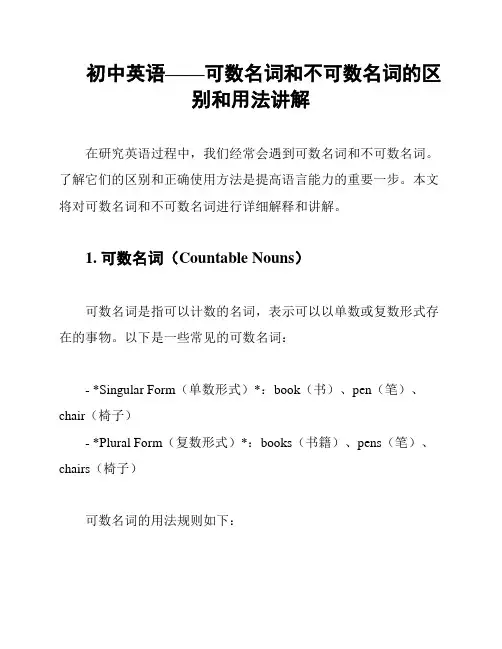
初中英语——可数名词和不可数名词的区别和用法讲解在研究英语过程中,我们经常会遇到可数名词和不可数名词。
了解它们的区别和正确使用方法是提高语言能力的重要一步。
本文将对可数名词和不可数名词进行详细解释和讲解。
1. 可数名词(Countable Nouns)可数名词是指可以计数的名词,表示可以以单数或复数形式存在的事物。
以下是一些常见的可数名词:- *Singular Form(单数形式)*:book(书)、pen(笔)、chair(椅子)- *Plural Form(复数形式)*:books(书籍)、pens(笔)、chairs(椅子)可数名词的用法规则如下:- *Indefinite Article(不定冠词)*:当我们泛指某个可数名词时,使用不定冠词"a"或"an"。
- I bought a book yesterday.(我昨天买了一本书。
)a book yesterday.(我昨天买了一本书。
)- She has an apple in her hand.(她手里拿着一个苹果。
)an apple in her hand.(她手里拿着一个苹果。
)- *Definite Article(定冠词)*:当我们特指某个可数名词时,使用定冠词"the"。
- The book on the table is mine.(桌子上的那本书是我的。
)The book on the table is mine.(桌子上的那本书是我的。
)- The boys are playing soccer in the park.(那些男孩在公园里踢足球。
)The boys are playing soccer in the park.(那些男孩在公园里踢足球。
)- *Plural Form(复数形式)*:当我们需要表示可数名词的复数时,在名词后面加上"s"。
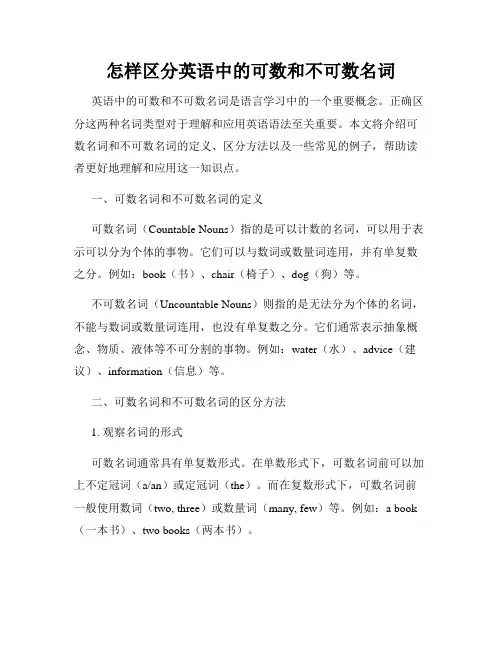
怎样区分英语中的可数和不可数名词英语中的可数和不可数名词是语言学习中的一个重要概念。
正确区分这两种名词类型对于理解和应用英语语法至关重要。
本文将介绍可数名词和不可数名词的定义、区分方法以及一些常见的例子,帮助读者更好地理解和应用这一知识点。
一、可数名词和不可数名词的定义可数名词(Countable Nouns)指的是可以计数的名词,可以用于表示可以分为个体的事物。
它们可以与数词或数量词连用,并有单复数之分。
例如:book(书)、chair(椅子)、dog(狗)等。
不可数名词(Uncountable Nouns)则指的是无法分为个体的名词,不能与数词或数量词连用,也没有单复数之分。
它们通常表示抽象概念、物质、液体等不可分割的事物。
例如:water(水)、advice(建议)、information(信息)等。
二、可数名词和不可数名词的区分方法1. 观察名词的形式可数名词通常具有单复数形式。
在单数形式下,可数名词前可以加上不定冠词(a/an)或定冠词(the)。
而在复数形式下,可数名词前一般使用数词(two, three)或数量词(many, few)等。
例如:a book (一本书)、two books(两本书)。
不可数名词没有复数形式,它们总是用单数形式出现,前面不能使用不定冠词。
有时,不可数名词前可以使用单位词或量词(a glass of water,a piece of advice),但这只是表达数量而非复数形式。
2. 观察可数性的特点可数名词和不可数名词的可数性可以通过以下特点来判断。
(1)可数名词可以与数字连用,表示具体数量。
例如:two dogs(两条狗)。
(2)可数名词可以与复数形式的限定词连用,表示不确定或者泛指。
例如:some books(一些书)。
(3)不可数名词无法与数字或复数形式的限定词连用,只能使用不可数形式的限定词。
例如:some water(一些水)。
三、常见的可数名词和不可数名词下面列举一些常见的可数名词和不可数名词,以便读者更好地理解。

英语可数名词和不可数名词知识点教案一、引言在学习英语过程中,掌握好可数名词和不可数名词是非常重要的基础知识。
本教案旨在帮助学生深入理解可数名词和不可数名词的概念、用法以及区别,并通过举例和练习来加深学生对这一知识点的掌握。
二、可数名词1. 可数名词的定义可数名词指的是可以用数字进行计数的名词,即可以用a、an、one、two等表示单数和复数的数量词来修饰的名词。
2. 可数名词的用法(1)可数名词的单数形态可数名词的单数形态是指名词表示一个人或一件事物时的形式。
例如:cat(猫)、book(书)。
(2)可数名词的复数形态可数名词的复数形态是指名词表示多个人或多件事物时的形式。
复数形态通常有以下几种变化:- 在名词末尾加-s,例如:cats(猫们)、books(书们);- 在以s、x、z、ch、sh结尾的词后面加-es,例如:boxes(盒子们)、watches(手表们);- 在以元音字母+y结尾的名词中,将y变为i加-es,例如:ladies(女士们)、stories(故事们);- 存在一些不规则变化的名词,例如:children(孩子们)、oxen(牛们)。
3. 可数名词的用于表示数量可数名词可以用来表示数量,可以和基数词连用,如:a cat(一只猫)、two books(两本书)。
三、不可数名词1. 不可数名词的定义不可数名词指的是不能用数字进行计数的名词,即无法用数量词修饰的名词。
2. 不可数名词的用法(1)不可数名词通常表示一种物质、材料、抽象概念等。
例如:milk(牛奶)、sugar(糖)。
(2)不可数名词没有复数形态,不能与a、an等数量词连用。
但是,有些不可数名词可以转化为可数名词来表示数量,例如:- a cup of coffee(一杯咖啡)- two bottles of water(两瓶水)四、可数名词和不可数名词的区别1. 计数方式的不同可数名词可以用数字进行计数,而不可数名词不能用数字进行计数。
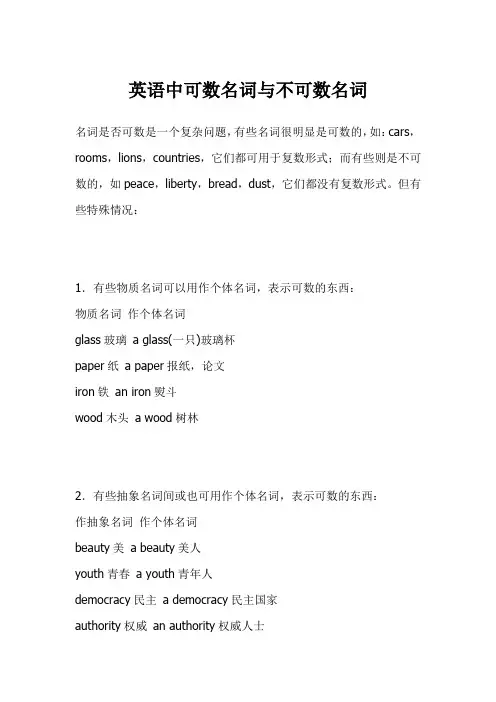
英语中可数名词与不可数名词名词是否可数是一个复杂问题,有些名词很明显是可数的,如:cars,rooms,lions,countries,它们都可用于复数形式;而有些则是不可数的,如peace,liberty,bread,dust,它们都没有复数形式。
但有些特殊情况:1.有些物质名词可以用作个体名词,表示可数的东西:物质名词作个体名词glass玻璃a glass(一只)玻璃杯paper纸a paper报纸,论文iron铁an iron熨斗wood木头a wood树林2.有些抽象名词间或也可用作个体名词,表示可数的东西:作抽象名词作个体名词beauty美a beauty美人youth青春a youth青年人democracy民主a democracy民主国家authority权威an authority权威人士3.有些个体名词也可用作抽象名词:作个体名词作抽象名词three rooms room for improvementa flower be in flowera church go to churcha hospital be in hospital4.有很多名词,在一种情况下为不可数名词,而在另一种情况下却为可数名词:Have some tea.喝点茶。
It’s a wonderful tea.这是一种极好的茶。
I love ice—cream.我喜欢冰淇淋。
Two ice—creams.please.请来两份冰淇淋。
I hate empty talk.我讨厌空谈。
She’s going to give us a talk.她将给我们作一次报告。
I got here without any difficulty.我到这里毫无困难。
He’s having financial difficulties.他经济上有困难。
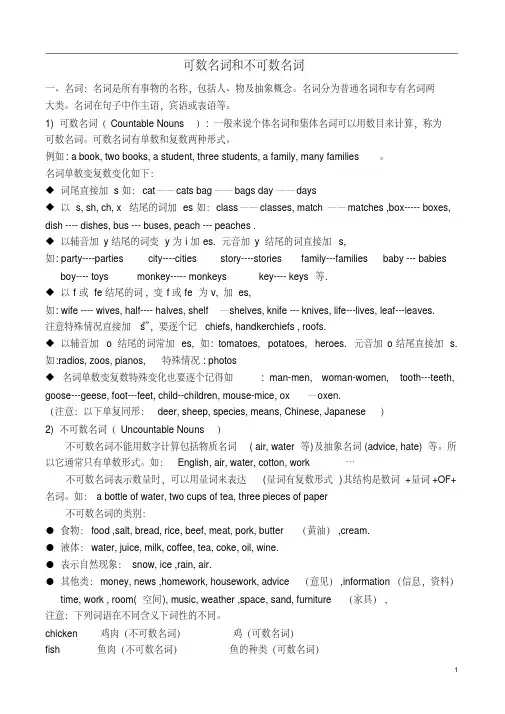
可数名词和不可数名词一、名词:名词是所有事物的名称,包括人、物及抽象概念。
名词分为普通名词和专有名词两大类。
名词在句子中作主语,宾语或表语等。
1) 可数名词(Countable Nouns): 一般来说个体名词和集体名词可以用数目来计算,称为可数名词。
可数名词有单数和复数两种形式。
例如: a book, two books, a student, three students, a family, many families。
名词单数变复数变化如下:◆词尾直接加s如:cat——cats bag——bags day——days◆以s, sh, ch, x 结尾的词加es如:class——classes, match——matches ,box----- boxes, dish ---- dishes, bus --- buses, peach --- peaches .◆以辅音加y结尾的词变y为i加es. 元音加y 结尾的词直接加s,如: party----parties city----cities story----stories family---families baby --- babies boy---- toys monkey----- monkeys key---- keys等.◆以f或fe结尾的词, 变f或fe 为v, 加es,如: wife ---- wives, half---- halves, shelf—shelves, knife --- knives, life---lives, leaf---leaves.注意特殊情况直接加“s”,要逐个记chiefs, handkerchiefs , roofs.◆以辅音加o 结尾的词常加es, 如: tomatoes, potatoes, heroes. 元音加o结尾直接加s. 如:radios, zoos, pianos, 特殊情况: photos◆名词单数变复数特殊变化也要逐个记得如: man-men, woman-women, tooth---teeth, goose---geese, foot---feet, child--children, mouse-mice, ox—oxen.(注意:以下单复同形:deer, sheep, species, means, Chinese, Japanese)2) 不可数名词(Uncountable Nouns)不可数名词不能用数字计算包括物质名词( air, water等)及抽象名词(advice, hate)等。
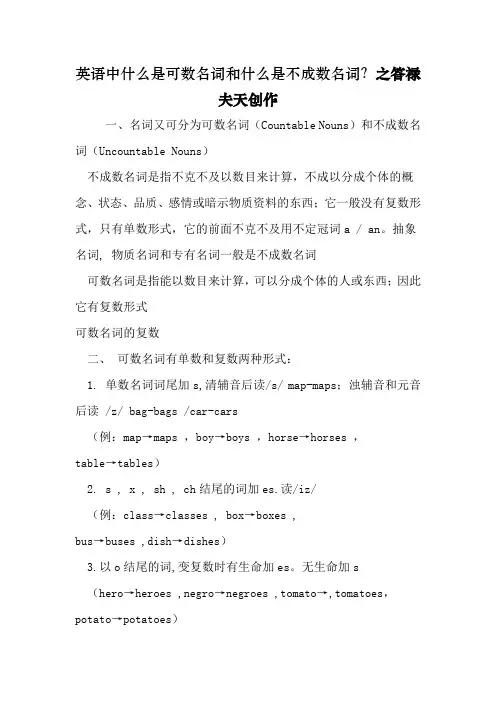
英语中什么是可数名词和什么是不成数名词?之答禄夫天创作一、名词又可分为可数名词(Countable Nouns)和不成数名词(Uncountable Nouns)不成数名词是指不克不及以数目来计算,不成以分成个体的概念、状态、品质、感情或暗示物质资料的东西;它一般没有复数形式,只有单数形式,它的前面不克不及用不定冠词a / an。
抽象名词, 物质名词和专有名词一般是不成数名词可数名词是指能以数目来计算,可以分成个体的人或东西;因此它有复数形式可数名词的复数二、可数名词有单数和复数两种形式:1. 单数名词词尾加s,清辅音后读/s/ map-maps;浊辅音和元音后读 /z/ bag-bags /car-cars(例:map→maps ,boy→boys ,horse→horses ,table→tables)2. s , x , sh , ch结尾的词加es.读/iz/(例:class→classes , box→boxes ,bus→buses ,dish→dishes)3.以o结尾的词,变复数时有生命加es。
无生命加s(hero→heroes ,negro→negroes ,tomato→,tomatoes,potato→potatoes)4. 以辅音字母加y结尾的名词,变y为i,再加es。
以y结尾的专有名词,以元音字母加y结尾的直接加s(例:family----families , city----cities,party----parties)5. 以f或fe结尾的名词,变f或fe为v,再加es。
(例:shelf---shelves , wolf---wolves , life---lives , knife --- knives)6.以ce,se,ze,(d)ge等结尾的词加s,读|z|7. 名词复数的不规则变更:(1)child----children Foot----feet Tooth----teeth Mouse---micefoot → feet tooth → teethox ----oxen man----men woman----women an Englishman----two Englishmen(2)单复同形deer,sheep,fish,Chinese,Japanese, species,means , Swiss 除人民币,美元、英镑、法郎等都有复数形式。
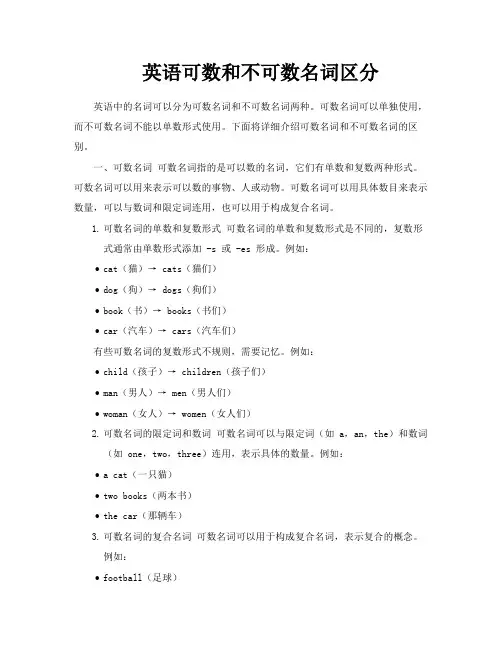
英语可数和不可数名词区分英语中的名词可以分为可数名词和不可数名词两种。
可数名词可以单独使用,而不可数名词不能以单数形式使用。
下面将详细介绍可数名词和不可数名词的区别。
一、可数名词可数名词指的是可以数的名词,它们有单数和复数两种形式。
可数名词可以用来表示可以数的事物、人或动物。
可数名词可以用具体数目来表示数量,可以与数词和限定词连用,也可以用于构成复合名词。
1.可数名词的单数和复数形式可数名词的单数和复数形式是不同的,复数形式通常由单数形式添加 -s 或 -es 形成。
例如:•cat(猫)→ cats(猫们)•dog(狗)→ dogs(狗们)•book(书)→ books(书们)•car(汽车)→ cars(汽车们)有些可数名词的复数形式不规则,需要记忆。
例如:•child(孩子)→ children(孩子们)•man(男人)→ men(男人们)•woman(女人)→ women(女人们)2.可数名词的限定词和数词可数名词可以与限定词(如 a,an,the)和数词(如 one,two,three)连用,表示具体的数量。
例如:•a cat(一只猫)•two books(两本书)•the car(那辆车)3.可数名词的复合名词可数名词可以用于构成复合名词,表示复合的概念。
例如:•football(足球)•bedroom(卧室)•blackboard(黑板)二、不可数名词不可数名词指的是不能以单数形式使用的名词,它们只有单数形式,不能与数词连用。
不可数名词通常表示抽象的概念、物质或集合。
不可数名词不能与不定冠词(a,an)连用,但可以与限定词(the)连用。
1.不可数名词的单数形式不可数名词只有单数形式,不能以复数形式出现。
例如:•water(水)•milk(牛奶)•sugar(糖)•information(信息)2.不可数名词的限定词不可数名词可以与限定词(如 the)连用,表示特定的物质或抽象概念。
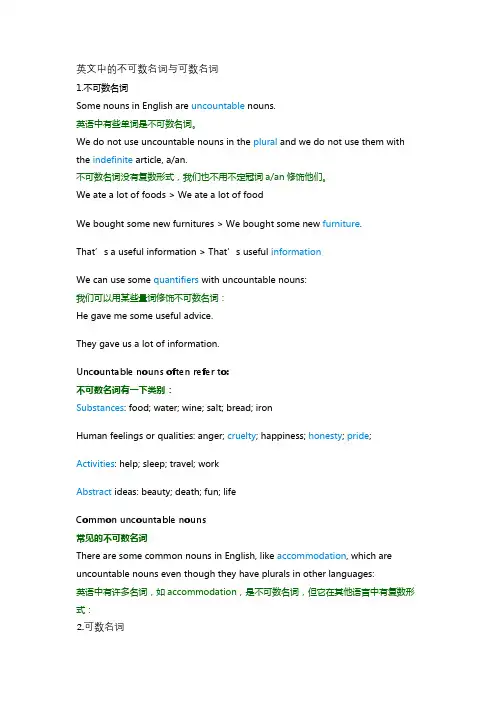
英文中的不可数名词与可数名词1.不可数名词Some nouns in English are uncountable nouns.英语中有些单词是不可数名词。
We do not use uncountable nouns in the plural and we do not use them with the indefinite article, a/an.不可数名词没有复数形式,我们也不用不定冠词a/an修饰他们。
We ate a lot of foods > We ate a lot of foodWe bought some new furnitures > We bought some new furniture.That’s a useful information > That’s useful informationWe can use some quantifiers with uncountable nouns:我们可以用某些量词修饰不可数名词:He gave me some useful advice.They gave us a lot of information.Uncountable nouns often refer to:不可数名词有一下类别:Substances: food; water; wine; salt; bread; ironHuman feelings or qualities: anger; cruelty; happiness; honesty; pride; Activities: help; sleep; travel; workAbstract ideas: beauty; death; fun; lifeCommon uncountable nouns常见的不可数名词There are some common nouns in English, like accommodation, which are uncountable nouns even though they have plurals in other languages:英语中有许多名词,如accommodation,是不可数名词,但它在其他语言中有复数形式:2.可数名词Count nouns have two forms: singular and plural.可数名词有两种形式:单数和复数。
初中英语名词知识点:可数名词和不可数名词英语中的绝大多数名词既可以用作可数名词也可以用作不可数名词。
1.可数名词
可数名词一般可以分成以下三类:
第一类:如bike,desk, factory等,这类名词占可数名词的多数。
以bike为例:
第二类:如clothes等,本身表示复数形式。
以clothes为例:
She cares for nice clothes.她爱好穿着。
2.不可数名词
不可数名词的用法特征主要有以下几种:
(1)不带冠词的单数形式需用动词单数作谓语。
例如:
(2)由much,little等词修饰。
例如:
(3)与表示单位的量词如a piece of等连用。
例如:
Go and fetch me a piece of chalk.给我去拿一支粉笔。
要十分注意的是:不可数名词不能与不定冠词或数词直接用在一起。
如不能说a good news, an advice, a hard work等。
不可数名词可以与量词使用构成不同的词组:
如: a piece of paper 一张纸 a drop of water
一滴水
a 1oaf of bread 一条面包 a bag of money 一袋钱
a bottle of milk 一瓶牛奶 a pair of shoes 一双鞋。
可数名词与不可数名词“分家”一、可数名词与不可数名词的区别普通名词所表示的人或事物是可以按个数计算的,这类名词叫可数名词。
可数名词分为个体名词(表示某类人或事物中的个体,如worker, farmer, desk, factory等)和集体名词(表示作为一个整体来看的一群人或一些事物,如people,family 等)。
如果普通名词所表示的事物是不能按个数来计算的,这类名词就叫不可数名词。
不可数名词分为物质名词(表示无法分为个体的物质,如meat, rice, water, milk, orange 等)和抽象名词(表示动作、状态、情况、品质等抽象概念,如work, homework, time, health, friendship等)。
不可数名词没有复数形式.二、可数名词的家务事可数名词有单数和复数两种形式。
指一个人或一件事物时,用单数形式;指两个或多个人或事物时用复数形式。
名词由单数形式变成复数形式的规则变化如下:1. 一般的名词词尾直接加-s 。
如:book → books room → roomshouse → houses map →maps2. 以s,ss, ch,sh, x 结尾的名词,在词尾加-es 。
如:bus → buses glass → glasses brush → brusheswatch → watches dish → dishes box → boxes3. 以"辅音字母+y"结尾的名词,要先将y改为i再加-es。
如:city → cities body → bodies party→ partiesfactory → factories story → stories family → families4. 以"元,音字母+y"结尾的名词,在词尾直接加-s. 如:boy → boys day→ days monkey → monkeys key → keys5. 以f 或fe 结尾的名词,要将f或fe改为v再加-es。
Countable and uncountable 1A noun can be countable or uncountable: Countable◇I eat a banana every day.◇I like bananas.Banana is a countable noun.A countable noun can be singular or plural. We can use numbers with countable nouns. So we can say ‘one banana’, ‘tow bananas’ etc. Example of nouns usually countable:◇Kate was singing a song.◇There’s a nice beach near here.◇Do you have a ten-pound not?◇It wasn’t your fault. It was an accident.◇There are no batteries in the radio.◇We don’t have enough cups.uncountable◇I eat rice every day.◇I like rice.Rice is an uncountable noun.An uncountable noun has only one form.We cannot use umbers with uncountable nouns.We cannot say ‘one rice’, ‘two rices’ etc.Examples of nouns usually uncountable:◇Kate was listening to some music.◇There’s sand in my shoes.◇Do you have any money?◇It wasn’t your fault. It was bad luck.◇There is no electricity in this house.◇We don’t have enough water.You can use a/an with singular countable nouns:a beach a student an umbrellaYou cannot use singular countable nouns alone (without a/the/my tec.):◇I want banana.◇There’s been accident.You can use plural countable nouns alone:◇I like bananas.◇Accidents can be prevented.You cannot normally use a/an with uncountable nouns. We do not say ‘a sand’, ‘a music’, ‘a rice’.But you can often use a … of. For example: a bowl/ a packet/ a grain ofriceYou can use uncountable nouns alone (without the/my/some ect.):◇I eat rice every day.◇There’s blood on your shirt.◇Can you hear music?You can use some and any with plural countable nouns:◇We sang some songs.◇Did you buy any apples?We use many and few with plural countable nouns.◇We didn’t take many pictures.◇I have a few things to do.You can use some and any with uncountable nouns:◇We listened to some music.◇Did you buy any apple juice?We use much and little with uncountable nouns:◇We didn’t do much shopping.◇I have a little work to do.ExercisesPart One: Some of these sentences need a/an. Correct the sentences where necessary.1. Joe goes everywhere by bike. He hasn’t got car.2. Helen was listening to music when I arrived.3. We went to very nice restaurant last weekend.4. I brush my teeth with toothpaste.5. I use toothbrush to brush my teeth.6. Can you tell me if there’s bank near here?7. My brother works for insurance company in Frankfurt.8. I don’t like violence.9. Can you smell paint?10. When we were in Rome, we stayed in big hotel.11. We need petrol. I hope we come to petrol station soon.12. I wonder if you can help me. I have problem.13. I like your suggestion. It’s very interesting idea.14. John has interview for job tomorrow.15. I like volleyball. It’s good game.16. Lisa doesn’t usually wear jewellery.17. Jane was wearing beautiful necklace.Part Two: Complete the sentences using the following works. Use a/an where necessary.1. It wasn’t your fault. It was __________.2. Listen! Can you hear _________?3. I couldn’t get into the house because I didn’t have __________.4. It’s very warm today. Why are you wearing ________?5. Do you take _____________ in your coffee?6. Are you hungry? Would you like ____________ with your coffee?7. Our lives would be very difficult without __________.8. ‘I had __________ for a job yesterday.’‘Did you? How did it go?’9. The heart pumps _______________ through the body.10. Excuse me, but can I ask you _____________?11. I’m not ready yet. Can you wait __________, please?12. We can’t delay much longer. We have to make __________ soon. Part Three: Complete the sentences using the following words. Sometimes the word needs to be plural, and sometimes you need to use a/an.1. I had my camera, but I didn’t take any ____________.2. There are seven ___________ in a week.3. A vegetarian is a person who doesn’t eat ___________.4. Outside the cinema there was _________ of people waiting to see the film.5. I’m not very good at telling ______________.6. Last night I went out with some _________ of mine.7. There were very few _____________ in town today. The streets were almost empty.8. I’m going out for a walk. I need some fresh ________.9. Gary always wants things quickly. He doesn’t have much _________.10. I think it’s going to rain. Do you have ________ I could borrow?11. Do you speak any foreign ___________?12. Our flat is very small. We don’t have much _________.。
一、概述在学习英语的过程中,词汇是一个至关重要的部分。
而在学习英语词汇的过程中,名词是其中的一大类。
在英语中,名词可以分为可数名词和不可数名词。
而三年级是学习英语的重要阶段,学生需要掌握这两类名词的用法,因此本文将重点探讨三年级英语可数名词和不可数名词的相关知识。
二、可数名词1. 可数名词的定义可数名词是指可以用数量来计算的名词,可以单数形式和复数形式表示。
例如:book(书)是可数名词,可以说one book(一本书)和two books(两本书)。
2. 可数名词的用法可数名词可以用来表示单个物品或多个物品,而且可以用基数词(如one, two, three)来修饰。
例如:two pens(两支笔)。
3. 可数名词的复数形式可数名词的复数形式一般在单词的末尾加上-s或-es。
例如:dog的复数形式为dogs,box的复数形式为boxes。
4. 可数名词的量词在表示可数名词时,还需要搭配一些量词,如many, a few, several等,来表示数量的大小。
例如:many books(许多书), a few apples(几个苹果)。
三、不可数名词1. 不可数名词的定义不可数名词是指无法用数量来计算的名词,通常是一种抽象的概念或无法分割的物质。
例如:water(水)是不可数名词,不能说one water或two waters。
2. 不可数名词的用法不可数名词只有单数形式,不能用复数形式表示。
而且不可数名词一般不与a或an连用。
例如:milk(牛奶)是不可数名词,不可以说a milk。
3. 不可数名词的量词不可数名词表示一种整体的概念,因此在表示数量时,通常使用一些表示容量或数量的词语,如some, a little, much等。
例如:some sugar(一些糖), a little butter(一些黄油), much rice(许多米饭)。
四、可数名词和不可数名词的区别1. 数量表示可数名词可以用数量词来修饰,而不可数名词通常使用表示容量或数量的词语来修饰。
英语可数名词和不可数名词知识点归纳可数名词和不可数名词是英语中名词的两个基本分类。
1. 可数名词(countable nouns):指可以用于计数的名词。
可数名词有单数和复数形式,可以与冠词或数词一起使用。
例如:book(书),apple(苹果),dog(狗)。
2. 不可数名词(uncountable nouns):指不能用于计数的名词。
不可数名词只有单数形式,不能与冠词(a,an)或复数形式一起使用,而要使用特定量词(如some,any,a lot of等)或量副词(如much,little,a little等)。
不可数名词通常表示抽象概念、材料、液体或信息。
例如:water(水),information(信息),love(爱),rice(米饭)。
下面是与可数名词和不可数名词相关的一些常见知识点:1. 可数名词的复数形式一般是在词尾加-s或-es,但也有一些特殊形式(如ox-oxen,man-men等)。
2. 不可数名词没有复数形式,因为它们本身就表示的是一个整体或连续的状态。
3. 有些名词既可以作可数名词又可以作不可数名词,其意义可能有所不同。
例如:glass(玻璃杯可数,玻璃不可数)、chair (椅子可数,椅子材料不可数)等。
4. 可数名词和不可数名词的用法在数量、形容词和冠词等方面有所不同。
例如,可数名词可以用数词修饰,而不可数名词必须使用度量词或量副词。
可数名词可以使用不定冠词a/an表示单数,而不可数名词则不能使用。
5. 可数名词和不可数名词在句子中的用法也有所不同。
可数名词可以用来表示单个物体或人,而不可数名词通常表示整体或一种物质。
了解可数名词和不可数名词的区别对于正确使用冠词、量词和形容词等很重要。
在学习英语语法和写作时,需要注意名词的分类和用法,以避免错误的句子结构和表达。
名词的可数与不可数在英语中,名词可以分为可数名词和不可数名词。
可数名词指的是可以直接用数目来计算的名词,而不可数名词则指不能用数目来计算的名词。
了解名词的可数和不可数性质对于正确理解和使用英语非常重要。
在本文中,我们将对名词的可数性和不可数性进行详细介绍。
一、可数名词可数名词是指可以用数目来计算的名词,可以用来表示一个或多个。
在句子中,可数名词可以单独使用,也可以与冠词、数词或形容词连用。
1. 单数形式可数名词的单数形式通常是原型,例如:book(书)、chair(椅子)、apple(苹果)等。
在句子中,可数名词的单数形式通常需要加上冠词或其他限定词。
例句:- I have a book.(我有一本书。
)- She bought an apple.(她买了一个苹果。
)2. 复数形式可数名词的复数形式通常是在单数形式末尾加上“s”或“es”。
在句子中,复数形式的可数名词不需要加上冠词。
例句:- They have many books.(他们有很多书。
)- We bought some chairs.(我们买了一些椅子。
)3. 可数名词的用法可数名词可以用来表示一个或多个,可以与不同的数词连用,形成单数或复数形式。
例句:- There is a dog in the park.(公园里有一只狗。
)- I have two brothers.(我有两个兄弟。
)- She ate three apples.(她吃了三个苹果。
)二、不可数名词不可数名词是指不能用数目来计算的名词,通常表示一种抽象的概念、物质或集合。
不可数名词在句子中不能直接用于复数形式,也不能与不定冠词连用。
1. 不可数名词的例子不可数名词包括许多日常生活中常见的名词,如:water(水)、coffee(咖啡)、information(信息)等。
2. 不可数名词的用法不可数名词不能与数词连用,也不能用于复数形式。
在句子中,不可数名词需要加上适当的限定词来修饰。
英语中的名词按其表示的事物性质的不同可分为可数名词与不可数名词。
这两种名词在用法上是有区别的,现归纳如下:
一、可数名词有单数、复数之分,如:
map→maps;onion→onions;baker→bakers
不可数名词没有复数形式,只有单数形式。
如:
some water;a lot of bread
二、单数可数名词表示泛指时,前面要用不定冠词a (an);而不可数名词不能用a(an)。
如:Li Hong is a driver. I am a teacher.李红是一名司机,我是一名教师。
We can't see milk on the table.我们看不见桌上有牛奶。
[友情提醒]在表示特指时,不可数名词和可数名词前都要用定冠词the。
如:
Pass me the ball,please.请把球传给我。
The chicken on the plate is yours.盘子里的鸡肉是你的。
三、可数名词表示复数意义时可用many等词修饰。
如:many apples,a lot of tomatoes,a few pens 不可数名词则要用much、a little等词修饰。
如:much meat,a little bread,little water
[Tips]这两类名词都可以被some、any、a lot of (lost of)等修饰。
如:some eggs/paper(纸)。
A lot of (lots of)knives/orange juice
四、可数名词前通常可用具体的数词来修饰。
如:
three women,ten babies
不可数名词表示数量的多少时,必须与表示数量的名词连用,即“数词+表示数量的名词(可数名词)+of+ 不可数名词”。
如:
two glasses of milk——两杯牛奶
five pieces of bread——五片面包
五、可数名词做主语时,谓语动词的单、复数与主语的单、复数须保持一致。
不可数名词做主语时,谓语动词只能用单数形式。
如:There is some rice in the bowl.碗里有些米饭。
All the students are in the classroom.所有的学生都在教室里。
[Tips]如果不可数名词前有复数名词短语修饰时,谓语动词须用复数形式。
如:There are two bags of rice in the room.房间里有两袋子大米。
六、对可数名词的数量提问用how many;对不可数名词的数量提问要用how much,但对不可数名词前表示数量名词中的修饰语提问时要用how many。
如:
I can see two pictures on the wall.→How many pictures can you see on the wall?
There is a lot of pork in the basket.→How much pork is there in the basket?
I want three glasses of water.→How many glasses of water do you want?
七、另外,有些集合名词也是可数名词,但不同的是,它们以单数形式出现,表示复数概念,如people,police,family等;而有些可数名词本身就以复数形式出现,如clothes,glasses(眼镜)等;有的可数名词单、复数形式相同,如Japanese,sheep,Chines e等。
如:
The Chinese people are hardworking and brave.中国人民勤劳勇敢。
The sports clothes are new.这些运动服是新的。
I have one sheep. He has two sheep.我有一只羊,他有三只羊。